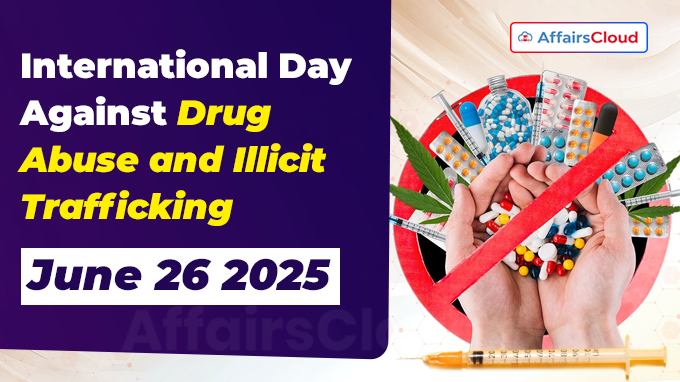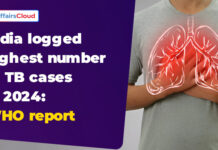 The United Nations (UN’s) International Day Against Drug Abuse and Illicit Trafficking, also known as World Drug Day is annually observed across the globe on June 26 to raise awareness about the threats posed by illicit drug use and promote international cooperation to combat drug abuse and trafficking.
The United Nations (UN’s) International Day Against Drug Abuse and Illicit Trafficking, also known as World Drug Day is annually observed across the globe on June 26 to raise awareness about the threats posed by illicit drug use and promote international cooperation to combat drug abuse and trafficking.
- The United Nations Office on Drugs and Crime (UNODC), headquartered in Vienna, Austria, leads the annual observance by selecting a campaign theme, conducting awareness drives.
Theme:
The 2025 theme for International Day Against Drug Abuse and Illicit Trafficking
is “Break the Cycle. #StopOrganizedCrime”, highlights the importance of sustained and targeted efforts to disrupt the ongoing cycle of organised crime and drug trafficking through long-term, coordinated action.
Background:
i.On 7 December 1987, the United Nations General Assembly (UNGA) adopted Resolution A/RES/42/112, officially designating 26 June as the annual International Day Against Drug Abuse and Illicit Trafficking.
ii.The Day also commemorates Lin Zexu, a Chinese official from the Qing Dynasty, who played a key role in halting the British Opium Trade in Humen, Guangdong Province, China, in 1839.
iii.The first International Day Against Drug Abuse and Illicit Trafficking was observed on June 26, 1989.
Global Drug Control Efforts:
i.The global drug problem was first recognised internationally during the first International conference on Narcotic Drugs held in 1909 in Shanghai, China.
ii.Since then, three major UN drug control conventions have been adopted:
- Single Convention on Narcotic Drugs (1961)
- Convention on Psychotropic Substances (1971)
- UN Convention Against Illicit Traffic in Narcotic Drugs and Psychotropic Substances (1988)
UN Institutional Action:
i.In 1946, the Commission on Narcotic Drugs (CND) was established under the United Nations Economic and Social Council (ECOSOC) to supervise the application of international drug control treaties.
ii.UNODC advocates a balanced, health-based approach to drug control.
iii.In 2009, UN member states agreed on a Political Declaration and Plan of Action on International Cooperation to develop an integrated strategy against the world drug problem.
iv.In 2019, CND approved a Ministerial Declaration reaffirming commitment to a drug-free world.
India’s Anti-Drug Efforts:
The Government of India(GoI) has implemented a strict zero-tolerance policy on drugs, backed by a focused, systematic, and coordinated strategy to combat drug abuse and trafficking.
i.The Narcotic Drugs and Psychotropic Substances (NDPS) Act, 1985 prohibits the production and sale of narcotic and psychotropic substances for non-medical and non-scientific purposes, prescribing stringent penalties for violations.
ii.The Narcotics Control Bureau (NCB), established on 17 March 1986, plays a central role in coordinating nationwide enforcement against drug trafficking.
- In 2024, drug seizures in India reached approximately Rs. 25,330 crore, marking a 55% increase from Rs. 16,100 crore in 2023, with a notable rise in the confiscation of synthetic drugs and cocaine.
iii.Nasha Mukt Bharat Abhiyaan (NMBA), launched on 15 August 2020 by the Ministry of Social Justice and Empowerment (MoSJE), is a nationwide initiative focused on the prevention of substance abuse, along with providing treatment and rehabilitation services across India.
iv.The National Action Plan for Drug Demand Reduction (NAPDDR:2018-25), launched and implemented by the Ministry of Social Justice & Empowerment, is a centrally sponsored scheme aimed at reducing drug demand through comprehensive prevention, treatment, and rehabilitation programs.
2025 UNODC World Drug Report:
On 26 June 2025, CND officially launched the UNODC World Drug Report 2025 at the Vienna International Centre (VIC) in Austria. The report provides science-based and critically analysed data on global trends in drug consumption, production, and trafficking.
Key Statistics from the Report:
i.316 million people (aged 15–64) globally used a drug (excluding alcohol and tobacco), representing 6% of the population, up from 5.2% in 2013.
ii.Cannabis remains the most widely used drug with 244 million users.
iii.Opioids are used by 61 million, followed by amphetamines (30.7 million), cocaine (25 million), and ecstasy (21 million).
Global Drug Statistics and Challenges:
i.Drug Usage: In 2022, around 292 million people (5.6% of the global population aged 15–64) used drugs, and 64 million suffered from drug-use disorders.
ii.Treatment Gap: Only 1 in 11 persons with drug disorders received treatment globally in 2022
iii.Economic Impact: The global drug problem imposes economic costs amounting to up to 2% of Gross Domestic Product (GDP) in some nations due to healthcare, crime, and lost productivity.
iv.Emerging Trends: In Southeast Asia, methamphetamine has overtaken opium and heroin in the illicit market. Cocaine markets are rapidly expanding in Africa and Asia.
About United Nation Office on Drugs and Crime (UNODC):
Executive Director(ED) – Ghada Fathi Waly
Headquarters – Vienna, Austria
Established – 1997




